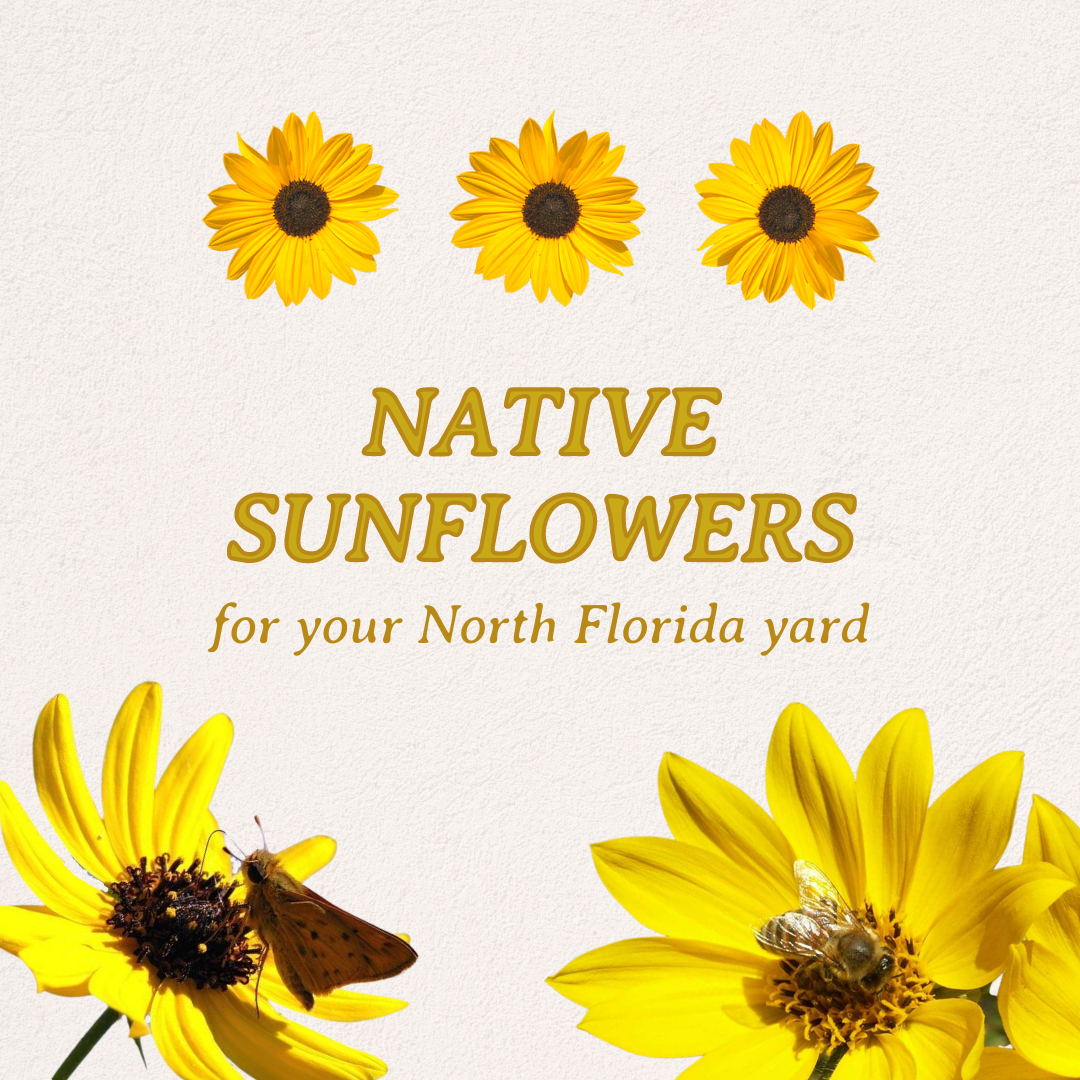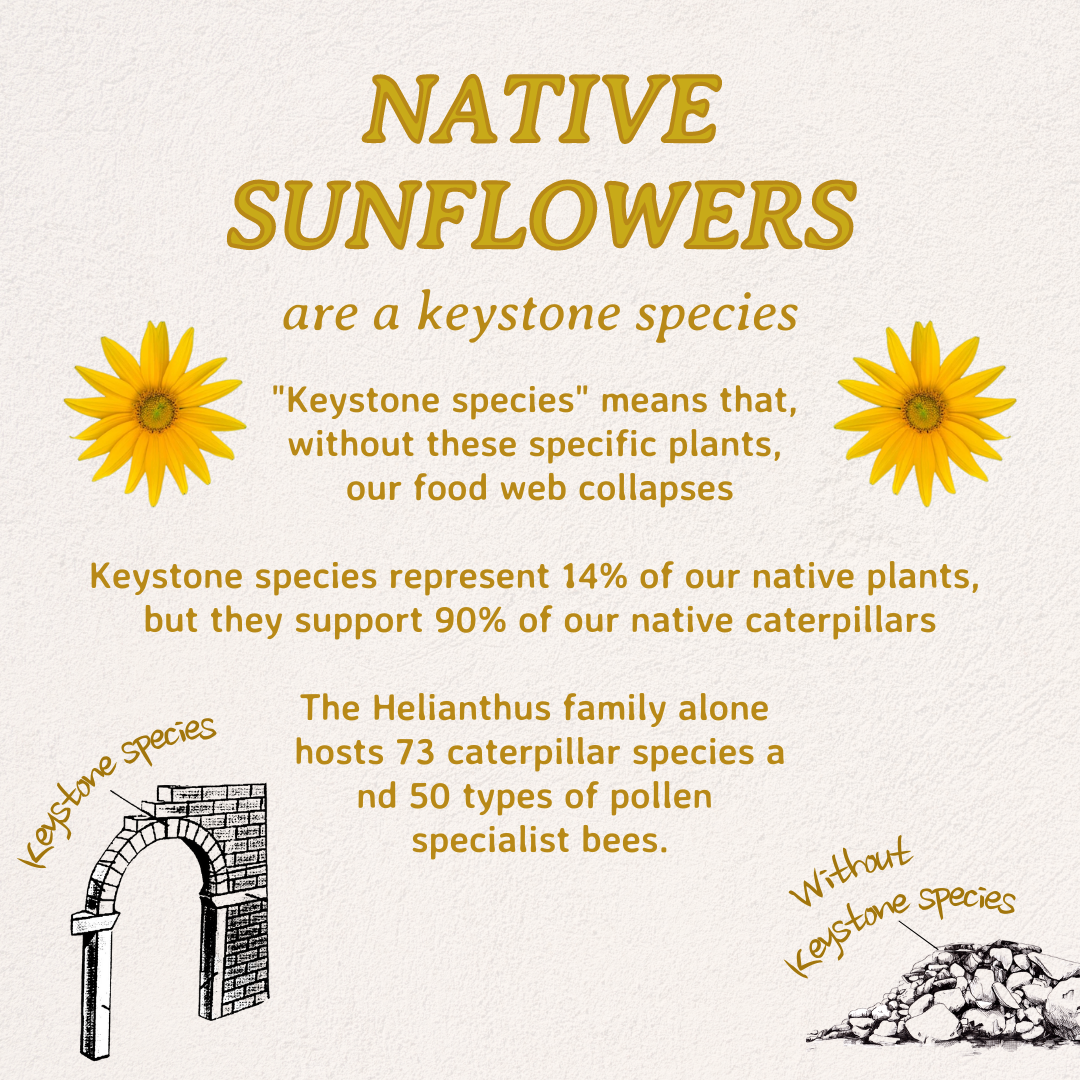The benefits of sunflowers are so abundant that no yard should be without them. I’m not referring to the large-headed annual cultivars you see growing in a field, but rather the native perennial sunflowers with small, bright yellow flowers seen growing along roadsides mid summer and early fall. As a genus, Helianthus gets a top-of-the-list rating for biodiversity value for herbaceous plants. They are tremendous nectar and host plants that support over 50 types of pollen specialist bees and over 73 species of caterpillars. In addition, their seeds provide a critical food source for many songbird species, such as cardinals, bluebirds, pine siskins, mourning doves, goldfinches, chickadees, and nuthatches.
According to the Florida Plant Atlas of Vascular Plants, there are 16 native species of sunflowers found throughout the state, including coastal areas. They come in a variety of different sizes and tolerate a wide range of soil and growing conditions. In fact, some species are not fit for a traditional garden bed setting because they have a tendency to out compete other desirable plants. However, because of their wildlife food value and natural beauty, we should strongly consider making space for them in our suburban yards.
The narrow-leaf sunflower, Helianthus angustifolius, is a beautiful addition to a natural area of the yard where it can ramble and spread. This powerhouse of a sunflower thrives in full to part sun and average to moist soil. It can grow anywhere from 5 to 8 feet tall and usually requires a little help with staking, especially with our pounding summer rains. The statuesque clumps are densely covered in 2-3 inch blooms that happily light up the garden by mid October. Majestic stands of this sunflower bloom in the coastal marshes of St. Mark–a sure indicator that fall has arrived–dappled throughout like endless waves of yellow. Blazing stars or native grasses, like chalky bluestem and yellow Indian grass, are great companion plants for narrow-leaf sunflowers due to their structural support and contrasting color ensembles.
Another moisture enthusiast is the lakeside sunflower, Helianthus carnosus. A rare endangered species that only occurs in five counties of North Florida. Unique in comparison to its relatives, this sunflower has a compact, low-growing rosette of leaves that shoot up 2 to 3 foot stalks of the typical, sunny yellow bloom by mid summer. As its common name implies, lakeside sunflower is a species of wet-soil habitats and full sun, and does not fare well when left to dry out. They do not spread aggressively like some of the other native sunflowers, making it a tame addition to the moisture loving wildflower garden in your landscape. Stoke’s aster, beardtongue, winged loosestrife, and brickellia are other native wildflowers that pair nicely with the lakeside sunflower.
The woodland sunflower, Helianthus divaricatus, grows by underground roots to make expanding colonies and it will self sow under the right conditions. In the wild it grows on dry, partially shaded woodland edges. However, in the rich and moist soils of your backyard it may become more aggressive. This species blooms in July and August, and can provide that much needed burst of color to the mid-summer shade garden. Depending on the conditions these plants can vary in height from 3 to 6 feet tall. They are a graceful addition to the fern patch where plants are left to grow wild–and then managed by the string trimmer once a year in late winter. Good companion plants for woodland sunflowers include southern woods fern, white indigo, white doll’s daisy and ironweed.
Also at the high end of the aggressiveness continuum, there is the notorious Jerusalem artichoke, Helianthus tuberosus. It is grown as a food crop, but recommended only in areas distant from other gardens, since in addition to being a rapid colonizer, the deep rhizomatic root system makes it difficult to eradicate once established–I have it growing in a patch where I can mow around it, which seems to stop it from spreading. The plants easily reach 5 to 6 feet tall and grow in full to part sun. The roots bear tubers that can be harvested after the first frost. When eaten raw, it has a crisp texture, like that of a water chestnut, and when cooked, the tuber has a soft, nutty flavor similar to potatoes.
Despite its name, the Jerusalem artichoke has no relation to Jerusalem, and little to do with artichokes. Native Americans (who called it “sunroot”) cultivated the tubers long before the arrival of the Europeans colonists. The sunroot got its recent name when a French explorer sent some plants back to his friend in Italy to cultivate in the Mediterranean climate. The Italian named the tuber “girasole articicco” simply meaning sunflower artichoke, believing that they tasted like artichokes. English speakers misunderstood the pronunciation of girasole, which they thought sounded more like “Jerusalem,” and so the name stuck.
Dune Sunflower, Helianthus debilis, is a low growing, short-lived perennial that often reseeds and spreads, especially in nutrient-poor and well-drained soils. Many gardeners like to use it as a colorful and drought-resistant groundcover in hot, dry sites, including coastal areas. One plant may quickly sprawl 4 to 6 feet across and generally no more than 1 to 2 feet in height. Dune sunflower thrives best in full sun and will bloom almost year-round from spring through fall. In a large sandy garden bed I would mix it with blue porterweed, blanket flower, dwarf fakahatchee grass, wild rosemary, red salvia, and seaside goldenrod.
Native sunflowers fulfill important niches in our plant communities. They provide food for our bees, butterflies, moths, and birds, as well as contribute color and texture to the beauty of our roadsides and other wild areas. It’s not too late to add a few splashes of the sunny yellow bloom to your own backyard habitat. There are many rewards to reap for such little investment, and with so much variety there’s a native sunflower for every garden.






